Mystic Funk
Active member
Awesome job Mystic, your killing it!
Just a thought my Oaxacan from 79 ran pretty good sized seeds, Just my 2 cents. looking forward to your progress.
Thank you very much vermontman!
We'll see what I get out of these seeds.

That would be awesome if I got something like your 79 Oaxacan!

that's just what I hear about the seed size I could be wrong?
peace!
mystic






